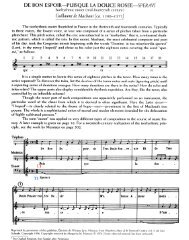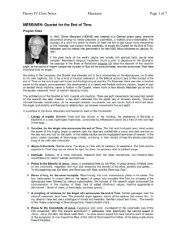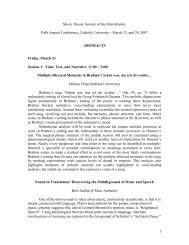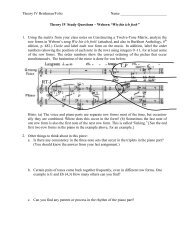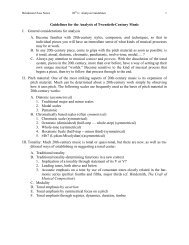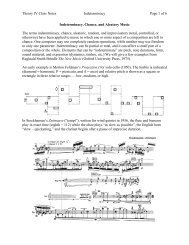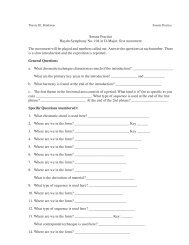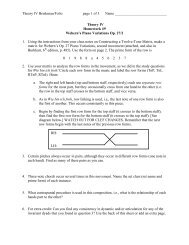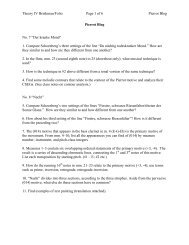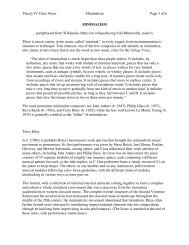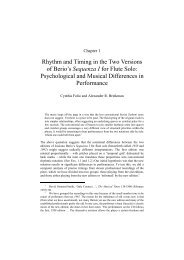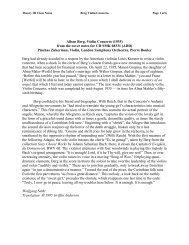Brinkman/Folio Theory IV Final Exam Study Guide (Spring 2009)
Brinkman/Folio Theory IV Final Exam Study Guide (Spring 2009)
Brinkman/Folio Theory IV Final Exam Study Guide (Spring 2009)
You also want an ePaper? Increase the reach of your titles
YUMPU automatically turns print PDFs into web optimized ePapers that Google loves.
<strong>Theory</strong> <strong>IV</strong> <strong>Final</strong> <strong>Study</strong> <strong>Guide</strong> <strong>Spring</strong> <strong>2009</strong> Page 1 of 5<br />
<strong>Brinkman</strong>/<strong>Folio</strong> <strong>Theory</strong> <strong>IV</strong> <strong>Final</strong> <strong>Exam</strong> <strong>Study</strong> <strong>Guide</strong> (<strong>Spring</strong> <strong>2009</strong>)<br />
Approximate makeup of <strong>Exam</strong><br />
Part I. Given the T 0 P tone row, write specified forms of that row (WITHOUT doing a matrix).<br />
Recall that you can calculate these directly from T 0 P using integers. For T n P add n to each<br />
pc in T 0 P; for RT n P, do the same, but work from the back to the front of the row. For T n I,<br />
subtract each pc in T 0 P row from n. For RT n I, do the same, but work backwards from the<br />
last to the first note of the row. Practice this using the rows from some of the pieces we have<br />
done in class and check your answers using the matrix. You will be asked to discuss<br />
properties of the row.<br />
Part II. 12-tone analysis. We will give you a matrix and a 12-tone composition. Identify the row<br />
forms used.<br />
Part III. Define terms, then name a piece (and its composer) that uses the technique (see<br />
Worksheet #2).<br />
Part <strong>IV</strong>. Given some excerpts, identify a term or some terms that might apply, e.g. “quartal<br />
harmony,” “mirror writing,” …<br />
Atonal Compositions<br />
Schoenberg: Pierrot Lunaire, “Mondestrunken,” “Der kranke Mond,” “Nacht” (1921)<br />
This landmark work for voice, flute (picc.), clarinet (b.clar.), violin (viola), cello, and<br />
piano (known now as the “Pierrot ensemble”) uses the technique of Sprechstimme almost<br />
exclusively in the vocal part. The collection is organized in three parts of seven poems<br />
each (“three times seven”) from Albert Giraud’s collection by the same name. We used<br />
contour analysis to identify variations on the “Pierrot motive,” a 7-note idea that appears<br />
throughout the first movement (G#-E-C-D-Bb-C#-G). The CAS for that motive is and the CSEG is . Schoenberg calls “Nacht” a passacaglia since it<br />
has a theme that is repeated many times. The first three notes of that theme (E-G-Eb), or<br />
(014), form the main motive for this piece.<br />
Twelve-Tone Compositions<br />
Webern: “Wie bin ich froh!” (1935)<br />
A 12-tone work based only on T 7 P, RT 7 I, RT 7 P and T 7 I; the 1 st stanza features the first<br />
two and the 2 nd stanza features the last two, but with a short return to the original pair; the<br />
song ends with a retrograde of the opening, suggesting the overall (loose) palindromic<br />
structure; the row contains several instances of set class 3-3(014), which becomes a<br />
prominent motive; the piano part is based on just a few rhythmic ideas, which also have<br />
particular articulation, dynamic, and pitch associations. The row forms used also feature<br />
dyad content invariance.<br />
Webern: Variations for Piano, Op. 27, II (1936)<br />
12-tone work; pointillistic texture; canon in inversion (between the 2 hands); registrally<br />
symmetrical around the note A 4 , which is emphasized through the repeated note figure
<strong>Theory</strong> <strong>IV</strong> <strong>Final</strong> <strong>Study</strong> <strong>Guide</strong> <strong>Spring</strong> <strong>2009</strong> Page 2 of 5<br />
(e.g. in m. 2). Like “Wie bin” there are certain rhythmic gestures that have particular<br />
dynamic, articulation, and pitch associations (this feature of Webern inspired the<br />
movement of total serialism).<br />
Schoenberg: Klavierstück, Op. 33a (1928)<br />
A twelve-tone piece in pseudo-sonata form that uses hexachord combinatoriality (pairs of<br />
rows that can be juxtaposed vertically or melodically without pitch duplication between<br />
hexachords). The row is inversionally combinatorial. Through most of the piece<br />
Schoenberg uses the combinatorial row pair T a P and T 3 I and their retrogrades. In the<br />
development he emphasizes hexachords, and uses other pairs of rows that share the same<br />
combinatorial relationship (T n P with T n+5 I): T 0 P and T 5 I, T 5 P and T a I, related to the first<br />
three pitches in the primary 12-tone row (Bb, F, and C).<br />
Berg: Violin Concerto (1935)<br />
Written in memory of Manon Gropius after her death. The 12-tone row alternates<br />
overlapping minor and major triads, and then finishes with a whole-tone segment (G Bb<br />
D F# A C E G# B C# D# F). The beginning of the concerto uses notes 1, 3, 5, 7 of the<br />
row (G, D, E, A) = the open strings of the violin. The piece uses two “found objects,” i.e.<br />
pre-existing material incorporated into the composition: a Corinthian folk song and a<br />
Bach Chorale. The last part of the concerto quotes and presents variations on Bach’s<br />
chorale, Es ist genug (“It is enough”), the first four notes of which are suggested by the<br />
whole-tone segment at the end of the row.<br />
<strong>Folio</strong>: “Cadmium Red Light” from Developing Hues (1990)<br />
This is the third and last movement of Developing Hues for flute and bass clarinet. The<br />
movement is based on a 12-tone row that features a compound melody with three<br />
embedded chromatic lines, which are often brought out in the composition through<br />
octave displacement, doubling, and dynamics. The flute and bass clarinet are in octaves<br />
or double octaves for most of the movement, although they sometimes alternate and<br />
sometimes one holds tones in the chromatic lines to bring them out of the texture. (See<br />
PowerPoint presentation online and class notes (printout of the PowerPoint)).<br />
Other Techniques<br />
Ruth Crawford Seeger: Diaphonic Suite No. 1, III and <strong>IV</strong> (1930) [<strong>Folio</strong> Lecture]<br />
<strong>IV</strong>: uses “verse form” (lines of music arranged like poetry); many examples of RI-chains;<br />
(012) is her “signature” motive.<br />
III: uses a 7-note row that is rotated and which appears on 3 levels: within the bar, from<br />
bar to bar, and from phrase to phrase (since the first note of each phrase determines the<br />
transposition level of the set)<br />
Messiaen: “Liturgie de cristal,” first movement of Quartet for the End of Time (1940–1941)<br />
Makes use of isorhthmic techniques in the piano chords and in the cello part. The clarinet<br />
and violin imitate bird songs.
<strong>Theory</strong> <strong>IV</strong> <strong>Final</strong> <strong>Study</strong> <strong>Guide</strong> <strong>Spring</strong> <strong>2009</strong> Page 3 of 5<br />
Messiaen: “Danse de la fureur, pour les sept trompettes,” No. VII of Quartet for the End of Time<br />
Demonstrates Messiaen’s technique of added rhythmic values; the middle section<br />
illustrates non-retrogradable rhythms and nonstandard augmentations and diminutions.<br />
Carter: “Canaries,” from Eight Pieces for Four Timpani (1950–1966)<br />
Features metric modulation (proportional changes of tempo), changing meter,<br />
polyrhythm; main rhythmic motive is typical of the “Canary” (a 17 th -century French<br />
dance) from the Canary Islands. Formally, the piece moves twice away from the opening<br />
tempo (dotted quarter = 90) and returns twice to it through varying tempi routes.<br />
Minimalism<br />
Riley: In C (1964)<br />
Comprised of 53 composed snippets, much of the piece is determined by the performers,<br />
including instrumentation, duration (of the work), and dynamics. Early example of<br />
minimalism (1964).<br />
Reich: Clapping Music (1972), Violin Phase (1967), Piano Phase (1967), Come Out (1966)<br />
All three works feature “phasing” (technically rhythmic rotation in Clapping Music, see<br />
notes on Seeger), a technique in which two (or more) parts begin in unison and gradually<br />
shift apart. Piano Phase does this with two live musicians, Violin Phase with a violinist<br />
playing with two separate recordings of himself playing, and Come Out with a recorded<br />
voice playing on tape loops. Since Come Out is constructed by manipulating recorded<br />
natural sounds (a voice), it is another example of musique concrete (see Stockhausen<br />
under Sound-Mass Compositions, below.) For more details, see class notes on<br />
Minimalism.<br />
Indeterminacy<br />
Cage: Aria (with Fontana Mix) (1958)<br />
The score is graphic, with contours, text, and colors. The vocalist chooses ten “voices” to<br />
associate with the various colors, and approximates the timing and contours from the<br />
graphic score. Performed with Cages electronic composition, Fontana Mix.<br />
John Cage: Lectures on Indeterminacy (1959)<br />
90 paragraph-length stories narrated by Cage, accompanied by David Tudor on the<br />
synthesizer and piano. Each story is told in a minute, so the speed of the narration depends<br />
on the length of the story.<br />
Cynthia <strong>Folio</strong>: When the Spirit Catches You … (2004)<br />
A multimedia work written for the Relâche Ensemble in Philadelphia. The work, which<br />
explores her daughter’s epilepsy, is divided into three parts, the aura (the subject’s sense<br />
that a seizure is about to occur), the seizure itself, and the post-ictal period (a time of<br />
confusion after the seizure is over). The piece is accompanied by visuals of art works<br />
created by artists with epilepsy, an EEG of a patient’s brain waves during a seizure, and<br />
quotations from Brainstorms (books by neurologist Steven Schachter that recount<br />
patients’ experiences during seizures), read by Dr. <strong>Folio</strong>’s daughter. Although much of<br />
the composition is written out, there are many “indeterminate” elements in which the
<strong>Theory</strong> <strong>IV</strong> <strong>Final</strong> <strong>Study</strong> <strong>Guide</strong> <strong>Spring</strong> <strong>2009</strong> Page 4 of 5<br />
composer provides a framework for controlled improvisation to achieve the desired<br />
effects.<br />
“Sound Mass” Pieces<br />
Penderecki: Threnody for the Victims of Hiroshima (1960)<br />
A sound-mass piece – the instruments are combined for sonic effect: tone colors, timbres,<br />
and “effect” are more significant that the specific pitches used. Some tone clusters are<br />
obtained by precise notation, while in other passages symbols indicate that each performer<br />
must play “as high as possible,” “between the bridge and tailpiece,” “on the bridge,” or<br />
using sharp or flat quartertones. All of these devices produce striking and strident “sound<br />
masses.”<br />
Stockhausen: Gesang der Jünglinge (1955–1956)<br />
Early example of musique concrete, or the manipulation of recorded sounds. One of the<br />
first multi-channel works, Stockhausen intended it to be performed with five<br />
loudspeakers giving the effect of the music whirling around the hall. Sounds used in the<br />
piece include electronically generated sounds and the manipulated recording of a boy’s<br />
voice.<br />
Ligeti: Atmospheres (1961)<br />
A sound-mass piece in which each instrument in the orchestra has a separate notated part<br />
(including each string player). Although the notation is precise the overall effect is of a<br />
gradually evolving mass of sound. It almost sounds like an electronically-generated<br />
piece.<br />
Ligeti: Lux Aeterna (1966)<br />
A vocal “sound-mass” piece for 16 vocal parts (4 soprano, 4 alto, 4 tenor, and 4 bass),<br />
written on the text for the communion from the Latin mass for the dead. Uses many<br />
chromatic clusters. The beginning of the composition (women’s voices) utilizes a 29-note<br />
series of pitches with much chromaticism. The voices enter and change pitches at different<br />
times (called “micro-polyphony” by Ligeti), designed to create chromatic “clusters” of<br />
pitches.<br />
Post-modern (Neo-Romantic)<br />
Penderecki: Concerto Grosso for Three Cellos and Orchestra (2001)<br />
An orchestra piece using the traditional concerto grosso principle (contrasting a small<br />
group of soloists with the orchestral tutti). In contrast to his early works such as<br />
Threnody, which were avant-garde and extremely dissonant, this later work represents his<br />
new lyrical and more consonant style. Even though the harmonies are triadic, he uses<br />
“gap-filling” technique to quickly cover the entire chromatic scale.<br />
Adams: Nixon in China (1985–1987)<br />
An opera about President Nixon’s week-long visit to China in 1972, which opened up<br />
relations between the US and China. The work shows the influence of minimalism, and<br />
the chord progressions frequently exhibit “parsimonious voice leading” – in which the<br />
voices move as smoothly as possible, with common tones and stepwise motion.
<strong>Theory</strong> <strong>IV</strong> <strong>Final</strong> <strong>Study</strong> <strong>Guide</strong> <strong>Spring</strong> <strong>2009</strong> Page 5 of 5<br />
Schwantner: Sparrows (1979)<br />
A chamber piece for soprano, flute, clarinet, violin, viola, cello, piano, and percussion.<br />
The string instruments are tuned scordatura (in this case, a half-step lower than usual for<br />
every string) and some of the instrumentalists are required to sing. The style of the piece<br />
can be called “post-modern” because it is a reaction to the extreme modernism<br />
represented by some of the “intellectual” music of the ‘50’s and ‘60’s, especially by<br />
serial composers (including Schwantner himself). The piece is eclectic in that it mixes<br />
many styles, but there is an overarching lyricism throughout. The piece is in an arch<br />
form, representing the idea of the cycle of day and night, reflected musically by<br />
movement from quasi-tonal to atonal and back to quasi-tonal; this cycle is also reflected<br />
in the fact that there is a “tonal cycle” and an “atonal cycle.” The composer draws on a<br />
few “serial” procedures, such as invariance, construction of the atonal cycle from setclasses<br />
(014) and (0126), diatonic combinatoriality, and unification of pitch centers<br />
through the primary motive of [-3].



